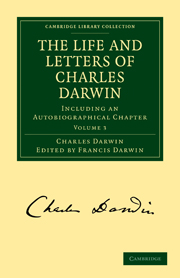Book contents
- Frontmatter
- Contents
- CHAPTER I THE SPREAD OF EVOLUTION. ‘VARIATION OF ANIMALS AND PLANTS’—1863–1866
- CHAPTER II THE PUBLICATION OF THE ‘VARIATION OF ANIMALS AND PLANTS UNDER DOMESTICATION’—JAN. 1867–JUNE 1868
- CHAPTER III WORK ON ‘MAN’—1864–1870
- CHAPTER IV THE PUBLICATION OF THE ‘DESCENT OF MAN.’ THE ‘EXPRESSION OF THE EMOTIONS’—1871–1873
- CHAPTER V MISCELLANEA, INCLUDING SECOND EDITIONS OF ‘CORAL REEFS,’ THE ‘DESCENT OF MAN,’ AND THE ‘VARIATION OF ANIMALS AND PLANTS’—1874–1875
- CHAPTER VI MISCELLANEA (continued). A REVIVAL OF GEOLOGICAL WORK—THE BOOK ON EARTHWORMS—LIFE OF ERASMUS DARWIN—MISCELLANEOUS LETTERS—1876–1882
- BOTANICAL LETTERS
- CHAPTER VII FERTILISATION OF FLOWERS—1839–1880
- CHAPTER VIII THE ‘EFFECTS OF CROSS- AND SELF-FERTILISATION IN THE VEGETABLE KINGDOM’—1866–1877
- CHAPTER IX ‘DIFFERENT FORMS OF FLOWERS ON PLANTS OF THE SAME SPECIES’—1860–1878
- CHAPTER X CLIMBING AND INSECTIVOROUS PLANTS—1863–1875
- CHAPTER XI THE ‘POWER OF MOVEMENT IN PLANTS’—1878–1881
- CHAPTER XII MISCELLANEOUS BOTANICAL LETTERS—1873–1882
- CHAPTER XIII CONCLUSION
- APPENDICES
- INDEX
CHAPTER XI - THE ‘POWER OF MOVEMENT IN PLANTS’—1878–1881
Published online by Cambridge University Press: 29 August 2010
- Frontmatter
- Contents
- CHAPTER I THE SPREAD OF EVOLUTION. ‘VARIATION OF ANIMALS AND PLANTS’—1863–1866
- CHAPTER II THE PUBLICATION OF THE ‘VARIATION OF ANIMALS AND PLANTS UNDER DOMESTICATION’—JAN. 1867–JUNE 1868
- CHAPTER III WORK ON ‘MAN’—1864–1870
- CHAPTER IV THE PUBLICATION OF THE ‘DESCENT OF MAN.’ THE ‘EXPRESSION OF THE EMOTIONS’—1871–1873
- CHAPTER V MISCELLANEA, INCLUDING SECOND EDITIONS OF ‘CORAL REEFS,’ THE ‘DESCENT OF MAN,’ AND THE ‘VARIATION OF ANIMALS AND PLANTS’—1874–1875
- CHAPTER VI MISCELLANEA (continued). A REVIVAL OF GEOLOGICAL WORK—THE BOOK ON EARTHWORMS—LIFE OF ERASMUS DARWIN—MISCELLANEOUS LETTERS—1876–1882
- BOTANICAL LETTERS
- CHAPTER VII FERTILISATION OF FLOWERS—1839–1880
- CHAPTER VIII THE ‘EFFECTS OF CROSS- AND SELF-FERTILISATION IN THE VEGETABLE KINGDOM’—1866–1877
- CHAPTER IX ‘DIFFERENT FORMS OF FLOWERS ON PLANTS OF THE SAME SPECIES’—1860–1878
- CHAPTER X CLIMBING AND INSECTIVOROUS PLANTS—1863–1875
- CHAPTER XI THE ‘POWER OF MOVEMENT IN PLANTS’—1878–1881
- CHAPTER XII MISCELLANEOUS BOTANICAL LETTERS—1873–1882
- CHAPTER XIII CONCLUSION
- APPENDICES
- INDEX
Summary
The few sentences in the autobiographical chapter give with sufficient clearness the connection between the ‘Power of Movement,’ and one of the author's earlier books, that on ‘Climbing Plants.’ The central idea of the book is that the movements of plants in relation to light, gravitation, &c., are modifications of a spontaneous tendency to revolve or circumnutate, which is widely inherent in the growing parts of plants. This conception has not been generally adopted, and has not taken a place among the canons of orthodox physiology. The book has been treated by Professor Sachs with a few words of professorial contempt; and by Professor Wiesner it has been honoured by careful and generously expressed criticism.
Mr. Thiselton Dyer has well said: “Whether this masterly conception of the unity of what has hitherto seemed a chaos of unrelated phenomena will be sustained, time alone will show. But no one can doubt the importance of what Mr. Darwin has done, in showing that for the future the phenomena of plant movement can and indeed must be studied from a single point of view.”
The work was begun in the summer of 1877, after the publication of ‘Different Forms of Flowers,’ and by the autumn his enthusiasm for the subject was thoroughly established, and he wrote to Mr. Dyer: “I am all on fire at the work.”
- Type
- Chapter
- Information
- The Life and Letters of Charles DarwinIncluding an Autobiographical Chapter, pp. 329 - 338Publisher: Cambridge University PressPrint publication year: 2009First published in: 1887



